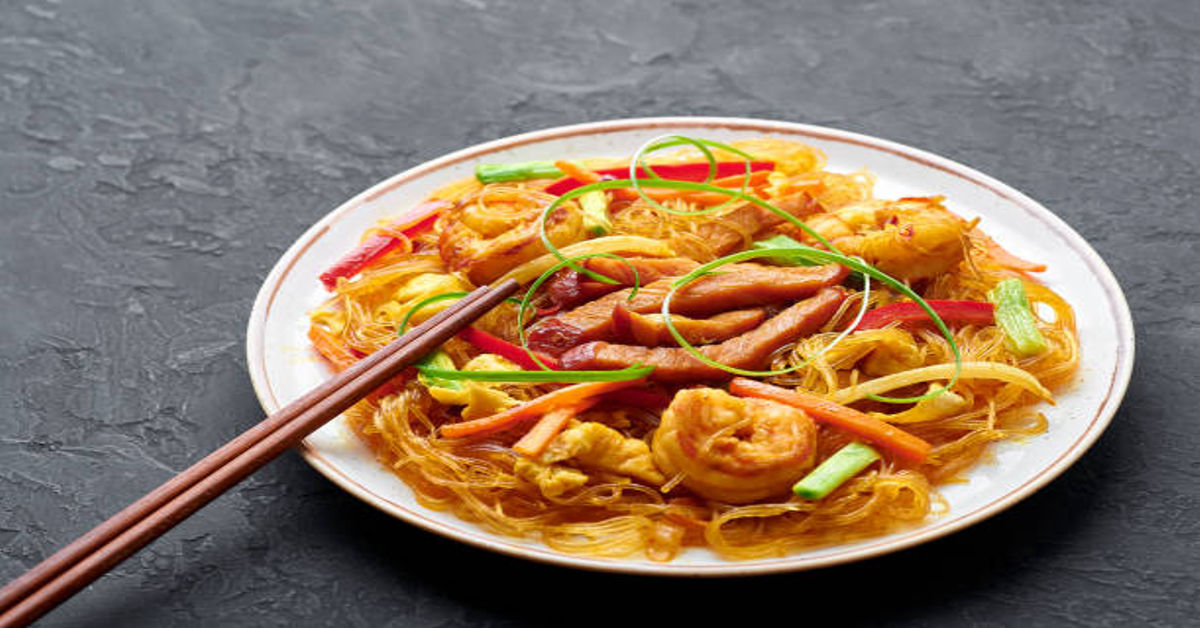Introduction
Among the vast world of Chinese cuisine, Mei Fun stands out as a timeless classic—light, flavorful, and deeply rooted in Asian culinary traditions. Known for its delicate rice noodles and ability to absorb flavors beautifully, Mei Fun represents more than just a dish—it is a symbol of balance, texture, and culture. Whether served stir-fried with vegetables and soy sauce, or mixed with shrimp, chicken, or curry, Mei Fun has traveled far beyond China to become a global favorite.
The name “Mei Fun” (米粉) literally translates to rice noodles or rice vermicelli. Originating from Southern China, this dish reflects centuries of food craftsmanship that values simplicity, balance, and nutritional harmony. Unlike wheat-based noodles, Mei Fun’s main ingredient—rice—gives it a naturally gluten-free, soft texture that appeals to modern eaters seeking healthy alternatives.
In this comprehensive article, we’ll explore every aspect of Mei Fun: its history, preparation, cultural significance, health benefits, varieties, and its growing international appeal. From Chinese family kitchens to American-Chinese restaurants, Mei Fun continues to connect people through taste, tradition, and creativity.
The Origins and History of Mei Fun
Mei Fun traces its origins to the southern provinces of China, particularly Guangdong and Fujian, regions known for rice cultivation and coastal trade. Historically, rice was not only a staple food but also a symbol of prosperity and life. The development of thin rice noodles represented a creative evolution of rice use—turning simple grains into versatile strands that could be preserved, transported, and cooked quickly.
In traditional Chinese society, Mei Fun was often prepared for festivals, family gatherings, and special occasions. It was prized for its smooth, tender texture and its ability to blend with other ingredients—reflecting the Chinese philosophy of harmony in flavor and form.
During the late 19th and early 20th centuries, Chinese immigrants brought Mei Fun recipes to Southeast Asia, the Caribbean, and the United States. There, it adapted to local tastes and ingredients, creating regional variations such as Singapore Mei Fun, Caribbean Chow Mei Fun, and American-style Shrimp Mei Fun.
| Region | Variation Name | Key Characteristics |
|---|---|---|
| Southern China | Mei Fun | Traditional light soy stir-fry with pork, shrimp, or egg |
| Singapore | Singapore Mei Fun | Curry-flavored with yellow tint and mixed vegetables |
| Caribbean | Chow Mei Fun | Includes jerk-style spices, seafood, or chicken |
| United States | Shrimp or Chicken Mei Fun | Adapted with mild soy sauce, green onions, and bell peppers |
This journey of adaptation demonstrates Mei Fun’s universal appeal and its ability to reflect the cultures it encounters.
Understanding Mei Fun Noodles
At its core, Mei Fun refers to thin rice vermicelli noodles, typically made from rice flour and water. These noodles are distinct from egg noodles or lo mein noodles, both of which are made from wheat. Rice vermicelli is translucent, light, and extremely absorbent—allowing sauces and seasonings to cling perfectly.
Ingredients of Mei Fun Noodles
The simplicity of Mei Fun noodles lies in its minimal ingredients, which create a naturally gluten-free base suitable for a wide range of diets.
| Main Ingredient | Purpose |
|---|---|
| Rice Flour | Provides the base texture and structure. |
| Water | Binds the flour and helps form a smooth batter. |
| Tapioca or Corn Starch (optional) | Adds elasticity and prevents breakage during cooking. |
The batter is spread into thin sheets, steamed, and then cut into fine strands—forming the iconic Mei Fun texture. The noodles are then dried or partially cooked for packaging, making them shelf-stable and easy to prepare worldwide.
Mei Fun vs. Other Noodles
It’s easy to confuse Mei Fun with other Asian noodles, but each type has unique characteristics. Understanding these differences helps in both cooking and appreciation.
| Noodle Type | Base Ingredient | Thickness | Common Dishes | Texture |
|---|---|---|---|---|
| Mei Fun (Rice Vermicelli) | Rice flour | Very thin | Stir-fry, soups | Soft, light |
| Ho Fun (Wide Rice Noodles) | Rice flour | Wide, flat | Chow Fun, Pho | Chewy |
| Lo Mein (Wheat Noodles) | Wheat flour, egg | Medium | Lo Mein, Chow Mein | Springy, dense |
| Glass Noodles | Mung bean starch | Thin, translucent | Hot pot, salads | Elastic |
| Udon (Japanese) | Wheat flour | Thick | Soups, stir-fries | Chewy, dense |
Among them, Mei Fun remains the lightest and most adaptable, suitable for both hot and cold dishes.
The Art of Cooking Mei Fun
Cooking Mei Fun is an art form rooted in timing and balance. Overcooking can lead to mushy noodles, while undercooking results in a hard, brittle texture. Traditionally, chefs prepare Mei Fun by soaking dry noodles in warm water until soft, then quickly stir-frying them with proteins, vegetables, and sauces in a wok over high heat.
Step-by-Step Preparation Guide
- Soak the Noodles: Place dry Mei Fun noodles in warm (not boiling) water for 5–7 minutes until they are soft but firm. Drain thoroughly.
- Prepare the Ingredients: Slice vegetables thinly—commonly used are carrots, cabbage, bell peppers, onions, bean sprouts, and green onions. Proteins like shrimp, chicken, or tofu are marinated in light soy sauce.
- Heat the Wok: Add a small amount of oil (preferably sesame or vegetable oil) and heat until it shimmers.
- Add Aromatics: Garlic, ginger, and sometimes chili are added to infuse the oil.
- Cook Proteins: Stir-fry the meat or tofu until cooked, then add vegetables.
- Combine Noodles and Sauce: Add the drained noodles to the wok, followed by soy sauce, oyster sauce, and sometimes curry powder (for Singapore-style Mei Fun). Toss rapidly to coat evenly.
- Finish and Serve: Garnish with chopped scallions, cilantro, or sesame seeds.
| Ingredient Category | Common Choices | Purpose in Dish |
|---|---|---|
| Protein | Shrimp, chicken, tofu, pork | Adds body and savory flavor |
| Vegetables | Cabbage, carrots, onions, bell peppers | Adds color, crunch, and nutrients |
| Seasoning | Soy sauce, oyster sauce, curry, sesame oil | Enhances depth of flavor |
| Garnish | Scallions, cilantro, sesame seeds | Provides freshness and aroma |
The result is a perfectly balanced dish that’s savory, aromatic, and visually appealing.
Nutritional Value and Health Benefits
Mei Fun is not just delicious—it’s also relatively healthy when prepared mindfully. Since it’s made from rice, it’s naturally gluten-free and low in fat. The final nutritional value, however, depends on preparation style.
| Nutrient (per 1 cup cooked) | Approximate Value | Health Benefits |
|---|---|---|
| Calories | 190–220 kcal | Provides energy |
| Carbohydrates | 45g | Supports body fuel and brain function |
| Protein | 4g | Builds and repairs tissues |
| Fat | 1g | Low-fat base when stir-fried lightly |
| Sodium | Variable | Can be controlled by reducing sauce use |
| Fiber | 1–2g | Aids digestion when paired with vegetables |
Health Tips for Mei Fun Lovers
- Choose lean proteins such as shrimp, tofu, or chicken breast.
- Add plenty of vegetables for fiber and vitamins.
- Limit high-sodium sauces; opt for low-sodium soy sauce.
- Use minimal oil during stir-frying for a lighter meal.
When balanced properly, Mei Fun can be a wholesome dish that fits into weight management, gluten-free, and heart-healthy diets.
Popular Varieties of Mei Fun Around the World
Mei Fun has traveled across continents, adapting to different cuisines and local ingredients. Let’s explore some of its famous variations:
1. Singapore Mei Fun
Despite its name, Singapore Mei Fun did not originate in Singapore but rather from Hong Kong chefs inspired by Southeast Asian flavors. It’s characterized by its golden-yellow color from curry powder and a mix of shrimp, eggs, and vegetables.
2. Shrimp Mei Fun
A popular option in Chinese restaurants worldwide, Shrimp Mei Fun combines lightly seasoned noodles with juicy shrimp, scallions, and soy sauce. The sweetness of shrimp complements the subtle saltiness of soy.
3. Vegetable Mei Fun
A vegetarian-friendly version filled with cabbage, bean sprouts, mushrooms, and carrots. Often flavored with light soy and sesame oil, it’s refreshing and rich in nutrients.
4. Hunan Mei Fun
Known for its spicy edge, Hunan Mei Fun features chili paste or hot oil for bold flavor. This variation is beloved by those who appreciate heat and intensity in their meals.
5. Caribbean Chow Mei Fun
In the Caribbean, Mei Fun has evolved with local spices, Scotch bonnet peppers, and jerk-seasoned meats. The result is a fusion of Chinese technique with Caribbean boldness.
| Variation | Key Ingredients | Flavor Profile |
|---|---|---|
| Singapore Mei Fun | Curry, egg, shrimp, vegetables | Spicy and aromatic |
| Shrimp Mei Fun | Shrimp, soy sauce, scallions | Savory and sweet |
| Vegetable Mei Fun | Mixed vegetables, sesame oil | Light and earthy |
| Hunan Mei Fun | Chili paste, garlic, pork | Spicy and smoky |
| Caribbean Chow Mei Fun | Jerk chicken, hot peppers | Spicy and tropical |
Each variation shows how adaptable Mei Fun is to regional cultures and tastes.
Cultural Symbolism and Significance
In Chinese culture, noodles often symbolize longevity and prosperity. Mei Fun, with its thin and endless strands, carries this symbolism as well. During festivals such as Lunar New Year or family reunions, long noodles represent a wish for a long, fulfilling life.
In Southeast Asia, Mei Fun dishes are often shared at gatherings, embodying togetherness and hospitality. Its simple yet elegant composition reminds people of balance—a key principle in both food and life.
Modern Interpretations and Fusion Dishes
The global food scene has embraced Mei Fun as a canvas for creativity. Modern chefs combine it with Western ingredients, creating innovative fusion dishes such as:
- Garlic Butter Shrimp Mei Fun (Chinese-American fusion)
- Vegan Coconut Curry Mei Fun (inspired by Thai cuisine)
- Teriyaki Beef Mei Fun Salad (a cold noodle fusion bowl)
- Mediterranean Mei Fun (olive oil, feta, and lemon-based dressing)
These creative versions retain the essence of Mei Fun—light, balanced, and texturally delightful—while introducing cross-cultural innovation.
Tips for Perfect Mei Fun Every Time
- Soak, Don’t Boil: Always soak rice noodles in warm water; boiling makes them soggy.
- Use a Hot Wok: Stir-fry quickly to preserve texture and prevent sticking.
- Cook Ingredients Separately: Meat, vegetables, and noodles should be cooked individually, then combined.
- Control Moisture: Too much sauce can make noodles heavy; aim for light coating.
- Serve Immediately: Mei Fun tastes best fresh from the wok, when the noodles remain airy and tender.
Storing and Reheating Mei Fun
If you have leftovers, store them properly to maintain quality.
- Refrigeration: Keep in an airtight container; lasts 3–4 days.
- Reheating: Use a wok or skillet on medium heat with a splash of water or oil.
- Freezing: Not recommended; rice noodles may become mushy when thawed.
Environmental and Cultural Sustainability
Mei Fun’s primary ingredient—rice—is both sustainable and deeply tied to Asian agricultural heritage. Many traditional farmers use eco-friendly practices, emphasizing biodiversity and water conservation. Supporting authentic, local producers helps maintain both the ecological and cultural integrity of the dish.
Conclusion
Mei Fun is much more than just a noodle dish; it is a bridge between simplicity and sophistication, tradition and modernity, East and West. Its journey from Chinese rice fields to international dining tables tells a story of cultural exchange, culinary artistry, and adaptability.
Whether you enjoy a plate of Singapore-style Mei Fun or a simple homemade vegetable version, you are partaking in centuries of culinary history rooted in balance, nourishment, and creativity. The dish’s delicate texture, nutritional value, and limitless variations make it a timeless favorite across generations.
FAQs
1. What is Mei Fun made of?
Mei Fun noodles are made primarily from rice flour and water. They are thin, gluten-free, and known for their soft, light texture.
2. Is Mei Fun healthy?
Yes, Mei Fun can be a healthy dish when cooked with lean proteins, plenty of vegetables, and minimal oil or sodium.
3. What’s the difference between Mei Fun and Chow Fun?
Mei Fun uses thin rice vermicelli noodles, while Chow Fun uses wide, flat rice noodles. Their texture and appearance differ significantly.
4. Can Mei Fun be made vegan or vegetarian?
Absolutely. Simply use tofu or plant-based protein and season with soy sauce, sesame oil, and vegetables.
5. How do I prevent Mei Fun noodles from sticking?
Soak noodles properly before cooking, toss them with a little oil, and stir-fry quickly over high heat to maintain separation.









